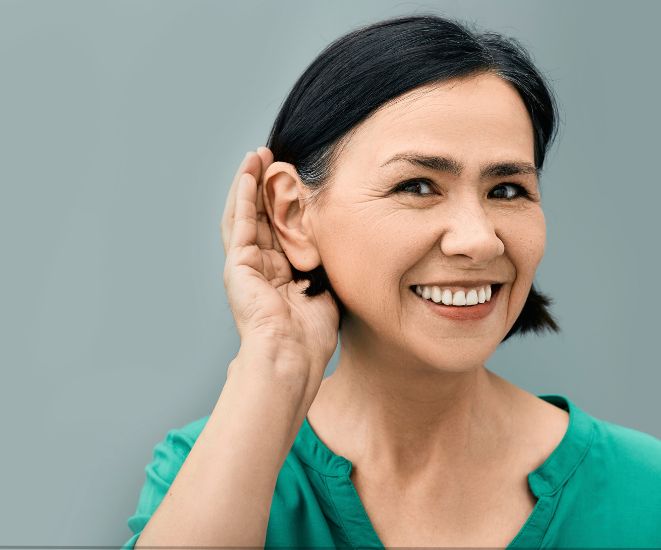Managing Tinnitus, Choosing Hearing Aids and Nutritional Tips
Did you know that what you eat or drink can have a large impact on your hearing and ear health? As difficult to believe as it may seem, our diets affect our bodies as a whole–and that includes your ears. Keep reading to learn more about common ear problems, symptoms, when to see a doctor and more.
Foods that Improve Hearing
- Fish (rich in omega-3 fatty acids).
- Leafy greens (such as spinach and kale).
- Nuts and seeds (especially walnuts and flaxseeds).
- Citrus fruits (like oranges and grapefruits).
- Bananas.
- Dark chocolate.
- Garlic.
- Avocados.
- Broccoli.
- Carrots.
Common Ear Problems
There are lots of different kinds of ear problems, many of which present similar symptoms. The best way to address your problems is by understanding what your diagnosis is and then treating it. Here are some of the most common ear problems you might be struggling with:
Tinnitus
Tinnitus is a condition characterized by a persistent ringing, buzzing, or humming sound in the ears. It can be caused by various factors, including exposure to loud noises, ear infections, and age-related hearing loss. Evidence suggests that tinnitus is caused by changes in neural networks in the brain.
Treatment options include sound therapy, hearing aids and cognitive-behavioral therapy to help manage the symptoms. While there are currently no medications approved by the U.S. Food and Drug Administration for treating tinnitus, research is being conducted.
Ear Infection
Ear infections occur when the narrow tubes that run from the middle ear to high in the back of the throat become swollen and blocked. This can lead to mucus build-up in the middle ear, and subsequently mucus can become infected and cause ear infection symptoms. Common symptoms in adults include ear pain, drainage of fluid from the ear and trouble hearing. You should see a doctor about your ear infection if:
Symptoms last for more than a day.
Ear pain is severe or debilitating.
You observe a discharge of fluid, pus or bloody fluid from the ear.
Hearing Loss
According to the National Institute on Deafness and Other Communication Disorders, 1 in 8 people in the United States (13%, or 30 million) ages 12 or older has hearing loss in both ears. About 5% of adults ages 45-54 have disabling hearing loss. The most common reasons for hearing loss include:
Damage to the Inner Ear
Aging and loud noise can cause wear and tear on the hairs or nerve cells in the cochlea that send sound signals to the brain. This inner ear damage can lead to hearing loss.
Buildup of Earwax
Over time, excess earwax can block the ear canal and keep sound waves from passing through, leading to hearing loss. This can be helped by removing the ear wax.
Ruptured Eardrum
Loud blasts of noise, sudden changes in pressure, poking an eardrum with an object and infection can cause the eardrum to burst.
Recognizing the symptoms of hearing loss is crucial for early intervention. Common symptoms include:
- Difficulty understanding conversations, especially in noisy environments.
- Frequently asking people to repeat themselves.
- Turning up the volume on the TV or radio higher than usual.
- Difficulty hearing high-pitched sounds like the phone ringing or birds chirping.
- Experiencing a feeling of fullness or pressure in the ears.
Tips for Maintaining Ear Health
Avoid Loud Noises
Protect your ears from loud environments by wearing earplugs or noise-canceling headphones.
Keep Ears Dry
Moisture can lead to infections. Dry your ears gently after swimming or showering.
Regular Check-ups
Schedule regular hearing tests, especially if you notice changes in your hearing.
Avoid Inserting Objects
Never insert objects into your ears, including cotton swabs, as this can cause damage.
Manage Stress
High-stress levels can exacerbate tinnitus and other ear problems. Practice stress management techniques such as meditation and exercise.
Best Options for Hearing Aids
- Behind-the-Ear (BTE) Hearing Aids.
- In-the-Ear (ITE) Hearing Aids.
- In-the-Canal (ITC) Hearing Aids.
- Completely-in-the-Canal (CIC) Hearing Aids.
- Receiver-in-Canal (RIC) Hearing Aids.
- Invisible-in-the-Canal (IIC) Hearing Aids.
- Bone-Anchored Hearing Aids (BAHA).
- Cochlear Implants.
- Rechargeable Hearing Aids.
- Bluetooth-Enabled Hearing Aids.

